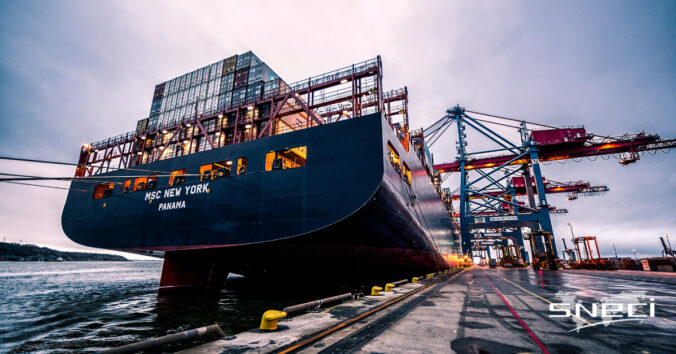What future for shipping?

What future for shipping? Maritime transport refers to the conveyance of people, especially for tourism, and goods by sea. According to the World Trade Organization (WTO), maritime transport accounts for over 80% of transported volumes and 90% of intercontinental trade in goods. The major challenge the sector faces is the lack of a replacement solution for heavy fuel oil. In this context, new players are betting on sails as a future propulsion method.
Despite its slowness, which can extend over several weeks or even months to reach its destination, this mode of transport has numerous advantages:
- It is particularly cost-effective, with customs fees more competitive than air, road, and rail transport.
- It allows the transportation of a larger volume of goods, notably through container ships.
- It covers intercontinental distances.
- It can transport flows of various kinds, from manufactured products, liquids, solid bulk, raw materials, and foodstuffs to vehicles, etc.
The impact of cargo ships on the environment and biodiversity
Today’s Supply Chain accounts for a significant portion of greenhouse gas emissions (GHGs). Maritime traffic is increasing so much that it could represent up to 17% of global emissions by 2050, according to international studies. Ships use fuels like diesel, but primarily heavy fuel oil. It is a sector that depends 99% on fossil fuels. “If shipping were a country, it would be the sixth most polluting in the world, between Germany and Japan,” says the Deputy Director of Equity Mid Cap Funds at Bpifrance.
Maritime transport is responsible for 3% of greenhouse gas emissions on the planet, amounting to 600 to 1100 MtCO2. With exchanges increasing over time, the trend does not seem to reverse, with volumes having increased by 250% in the last 40 years. At this rate, projections for 2050 estimate 17% of global GHG emissions emitted by maritime transport.
Why do ships pollute so much?
The carbon footprint of mainly consists of emissions from bunker fuel (a residue of oil obtained after refining gasoline and diesel). Considered heavy fuel oil and challenging to burn, its combustion releases carbon dioxide (CO2), methane (CH4), and nitrous oxide (N2O), the main gases responsible for climate change.
Maritime transport also has a significant impact on biodiversity. For example, a fuel leak at sea can cause infamous oil spills, destroying ecosystems both at sea and on the beaches where they wash ashore. Collisions between marine animals and ships are also not insignificant. Container ships can also lose part of their cargo, releasing contents into the water (as a result of plastic microbeads ending up on beaches or in fish stomachs). Finally, the noise from propeller blades and engines disrupts the orientation and communication of marine beings (we can talk about noise pollution).
What are the solutions?
Some startups have taken on the challenge of solving this shipping problem by attempting to address all these issues. The proposed solution: a return to sail transport. Projects have been launched, and several proposals have emerged.
The first involves using 100% sail-powered ships to reduce all air and ocean pollution during operation. Although delivery times would be longer, they would be much less polluting. This is the most ecological solution, reducing GHG emissions by up to 97% (the remaining 3% being emissions from ship construction) through 100% natural propulsion—wind.
The second solution involves creating hybrid ships with a conventional engine but equipping the vessel with a sail system (kite and inflatable sail attached to the bow) to reduce engine power and thus emissions. This proposal could save up to 80% of fuel.
The third solution would be to install sails on existing ships. They were not built for this type of propulsion, so they do not perform as well as the second solution. However, this method could reduce fuel consumption by only 20 to 30%. Nevertheless, this fuel saving is not negligible.
What is the future of this solution for shipping?
According to some studies (Clean Maritime Plan, WindShip), 40 to 45% of the world fleet (37,000 to 40,000 ships) could benefit from sail propulsion by 2050. Due to the lower cost of this technology and its widespread availability, these same studies indicate that 3,700 to 10,700 ships could be equipped with sail propulsion systems by 2030. Avoiding the emission of 3.5 to 7.5 million tons of CO2 could be achieved by 2030.
Sail-powered ships are, therefore, a serious solution that interests many shipowners. Indeed, maritime companies see an economic advantage. They would no longer have to buy as much fuel as before, depending on a natural and free resource—wind. All while drastically improving their carbon footprint.
Regarding the crew’s experience with this mode of navigation, it is lacking and is one of the points to significantly improve. It is important to note that sail propulsion requires wind. Therefore, maritime routes may need to be adjusted to take advantage of it. Crews can rely on maritime routing—taking into account weather conditions—essential for sail solutions. However, shipowners are not accustomed to this type of navigation, and there is a psychological barrier.
It should be noted that sail propulsion is more favorable on northern transatlantic routes and less so for navigation between Europe and Asia.
Conclusion
Overall, the future of shipping may lie in sails. Sail propulsion addresses new segments. Long-distance transportation of goods on medium-sized ships that can make stops in more ports, including secondary ones. This allows goods to be transported closer to the consumer. Aiming to reduce pre- and post-shipment, typically done by road transport. Speed is also reduced: the cargo will travel at an average speed of 11 knots. It is a virtuous logistics chain, and consumers must play a role by accepting longer delivery times.
It is logical to see new silhouettes on our coasts with the appearance of large sail cargo ships. Many entrepreneurial projects are emerging, especially in Brittany, promising a bright future for these ships.
Investors are waiting for startups to present satisfactory figures to inject more liquidity and develop this new market more massively.
The various solutions herald a promising future for shipping and, more broadly, for the Supply Chain. Indeed, the major challenge for companies today is to reduce their carbon footprint by decreasing their GHG emissions. The different levers include travel, sorting, home-to-office commute, etc.
Thus, sail cargo could allow companies to reduce their emissions through their Supply Chain. With a massive deployment of this mode of goods transport, could we drastically reduce GHG emissions on a global scale? Is sail shipping the future of the supply chain?
For more information on the subject, feel free to contact us via email at info@sneci.com or directly on the contact tab of our website!





